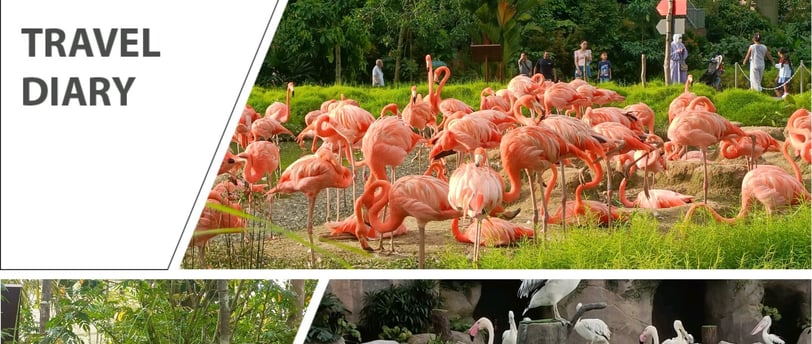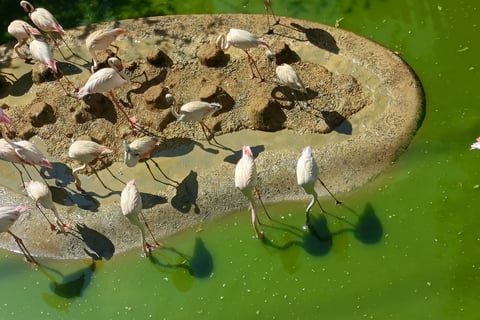Bird Paradise: A Symphony of Wings and Wonder
#Bird_paradise_Singapore, singapore
SOLO TRAVEL TIPSSINGAPORE TOURIST PLACE
Yatra kahani
5/4/20258 min read


Bird Paradise: A Symphony of Wings and Wonder
In a world increasingly dominated by concrete jungles and digital screens, the call of the wild still resonates through the gentle rustle of leaves, the chirp of a sparrow, and the distant cry of a soaring eagle. Among the most enchanting sanctuaries of the natural world is a bird paradise — a haven where feathered creatures of all shapes, sizes, and colors find shelter, sustenance, and serenity. A bird paradise is not just a refuge for birds; it is a living tapestry of biodiversity, a testament to the delicate balance of ecosystems, and a retreat for humans seeking solace in nature's embrace.
The Allure of Avian Life
The fascination that birds hold for humanity is both profound and multifaceted, drawing millions of enthusiasts to engage with avian life across the globe. Birds, with their vivid plumage and intricate patterns, evoke a sense of wonder. The delicate artistry of their feathers captivates not only amateur bird watchers but also professional ornithologists, highlighting nature’s incredible palette. This enchanting display of colors serves as one of nature’s most compelling forms of beauty, spurring joy and admiration in those who observe them.
Moreover, the complexity of bird songs adds another layer to their allure. Each species has developed unique vocalizations that serve various purposes, such as attracting mates, marking territory, or communicating with flock members. Birdsong, often described as a natural symphony, resonates through forests, wetlands, and urban parks alike, creating an auditory experience that many find soothing and delightful. The ability of birds to produce such a diverse range of sounds demonstrates both their adaptability and the ecological roles they play, further deepening interest in avian life.
The diverse behaviors exhibited by birds also contribute to their intrigue. From the elaborate courtship dances of the bowerbird to the complex migratory patterns seen in species like the Arctic Tern, birds display behaviors that reflect their survival and adaptation strategies. This behavioral complexity fosters curiosity and encourages humans to study and understand these remarkable creatures. Prominent bird watchers, such as John James Audubon and Roger Tory Peterson, have significantly advanced avian studies, documenting their findings and inspiring future generations to explore the world of birds.
As people continue to witness the spellbinding world of avian life through various lenses, the bond between humans and birds will likely flourish, emphasizing the importance of conservation efforts for these exceptional beings.
Ecosystems in Harmony
Birds are integral components of various ecosystems, playing vital roles that contribute to ecological balance. Their diverse interactions with habitats illustrate the intricate relationships that exist within ecosystems. For instance, many bird species serve as pollinators, assisting in the reproduction of flowering plants by transferring pollen from one bloom to another. This symbiotic relationship not only aids plant diversity but also promotes the sustenance of other wildlife that depend on these plants for food and habitat.
Moreover, birds act as essential seed dispersers, facilitating the spread of plant species across different environments. Some birds consume fruits and seeds, later excreting them in different locations, which encourages plant colonization and aids in maintaining healthy flora populations. This natural process enhances biodiversity and fortifies ecological resilience, illustrating how birds contribute to the overall health of their environments.
Additionally, birds can function as predators, regulating populations of insects and small mammals. This predation keeps these populations in check and prevents overgrazing or resource depletion within their habitats. For example, raptors such as hawks and owls play a critical role in controlling rodent populations, while insectivorous birds help manage insect outbreaks that can otherwise devastate vegetation. Through these interactions, birds help maintain a cohesive ecological balance, ensuring that no single species monopolizes resources to the detriment of others.
The interconnectedness of life forms within ecosystems is further underscored by the conservation of bird species. Protecting their habitats not only secures the survival of birds but also supports numerous other organisms and fosters healthier ecosystems. As stewards of biodiversity, birds embody the delicate balance that sustains life on Earth, making their protection essential for the integrity of our natural surroundings. In summary, the multifaceted roles birds play in ecosystems highlight their importance and reinforce the need for environmental conservation efforts.
Architectural Marvels of Nature
The intricate nests and habitats created by birds exemplify the remarkable engineering skills demonstrated in the animal kingdom. Birds exhibit a variety of nesting behaviors, which can vary significantly based on species, environment, and available materials. These remarkable structures serve not merely as shelters but also play crucial roles in reproduction, parenting, and survival.
For instance, the weaverbird is renowned for constructing remarkably complex nests, often woven from grass and twigs with impressive precision. These nests can hang from tree branches, providing protection for eggs and chicks against predators. Their intricate designs and elaborate entrances not only serve a functional purpose but also exemplify a unique aesthetic quality inherent in avian architecture. Similarly, the American robin builds relatively simpler nests from grass, mud, and other organic materials, showcasing a fundamental yet effective technique in creating a safe environment for their young.
On the other hand, the architecture of some birds, such as the cliff-nesting seabird, is significantly dictated by their ecological niche. By utilizing available substrates like rocky cliffs or ledges, these birds have adapted their nesting strategies to minimize exposure to predators while maximizing accessibility to food sources. The varied techniques across species illustrate a broader narrative of adaptation and survival in response to the diverse pressures of their habitats.
Moreover, the significance of these nests extends beyond individual species as they often contribute to the larger ecosystem. Abandoned nests can provide nesting materials for other species, while structures like those of the great blue heron can create unique microhabitats that support various plant and animal life. The diverse building methods not only reflect the unique characteristics of each bird species but also underline the interconnectedness of life, emphasizing that architectural marvels in nature are vital components of ecological balance.
A Haven for Birdwatchers and Nature Lovers
Across the globe, numerous locations serve as sanctuaries for birds, attracting both seasoned birdwatchers and casual enthusiasts alike. These exceptional habitats offer a unique opportunity to witness the elegance of avian life in their natural environments. The joy of birdwatching lies not only in the sights and sounds but also in the serenity that nature provides. Popular birding locations include the wetlands of the Florida Everglades, the temperate rainforests of Costa Rica, and the migration hotspots like Point Pelee in Canada. Each site presents distinct bird species and unique ecosystems, making them ideal for observation and appreciation.
To embark on your birdwatching journey, certain foundational tips can enhance the experience. Firstly, investing in a quality pair of binoculars is essential for visual clarity and detail. Next, familiarize yourself with local bird species through field guides or mobile applications dedicated to bird identification. These resources can significantly enhance one’s understanding and appreciation of the diversity within avian wildlife. Joining local birdwatching groups is also beneficial, as it provides an opportunity to learn from experienced birdwatchers and share the joys of discovery with a community that shares a common passion.
Furthermore, the social aspect of birdwatching cannot be understated. Collaborative outings encourage engagement, allowing individuals to connect over shared experiences and discoveries. Birdwatching fosters a communal spirit that often leads to conservation efforts within local ecosystems, reinforcing the importance of protecting these sanctuaries for future generations. This collective admiration for birds cultivates a deeper appreciation and awareness of our surroundings, ultimately highlighting the crucial role that nature plays in our lives.
Conservation Challenges and the Human Footprint
Birds, an integral part of our ecosystem, face numerous conservation challenges primarily due to human activity. Habitat loss stands as the most pressing issue, often resulting from urban development, agricultural expansion, and deforestation. According to various studies, more than 26% of bird species are currently threatened with extinction, a phenomenon driven largely by the destruction of their natural environments. For instance, wetlands, which are crucial for many avian species, have seen a dramatic decline in their availability—over 50% of these habitats have been lost worldwide.
Climate change further exacerbates the plight of bird populations. Fluctuations in temperature and changing weather patterns disrupt migratory routes and breeding cycles, posing additional threats to their survival. Studies have shown that shifts in climate over the last few decades have led to mismatches in food availability for many bird species, impacting their health and reproductive success. The RSPB (Royal Society for the Protection of Birds) indicates that around 60% of birds in the UK have experienced changes in their migration timings, some arriving at breeding grounds either too early or too late, severely affecting their ability to raise healthy chicks.
Moreover, pollution significantly impacts avian well-being, through both direct and indirect means. Pesticides and herbicides reduce food sources and lead to toxic exposure, while plastic waste contributes to mortality through ingestion and entanglement. Organizations dedicated to bird conservation, such as the Audubon Society, are tirelessly working to combat these issues, raising awareness and implementing restoration projects aimed at rebuilding habitats. However, they often face significant hurdles due to limited resources and resistance from industries contributing to environmental degradation. Resolute action is required to address these multifaceted challenges, thus protecting bird populations globally and maintaining biodiversity.
A Call to Coexistence
The intricate relationship between humans and birds has long been a subject of fascination, encompassing both challenges and opportunities for coexistence. As urbanization and habitat destruction continue to threaten avian populations, it becomes increasingly vital for individuals to engage in efforts that promote bird conservation and habitat preservation. Fostering a harmonious relationship with our avian counterparts not only enhances biodiversity but also enriches our own lives. By taking actionable steps, each person can contribute significantly to the well-being of birds in their communities.
One effective approach to supporting bird conservation is through the creation of bird-friendly environments. This can be achieved by planting native flora, which provides essential food and shelter. Homeowners can also set up bird feeders and baths, which not only attract various species but also encourage regular observation, thereby fostering a deeper connection with nature. Additionally, participating in local birdwatching clubs or community science projects can heighten awareness of the challenges faced by birds and galvanize collective action.
Moreover, educating oneself and others about the importance of avian ecosystems is crucial. Engaging in advocacy for local policies that protect natural habitats further enhances these efforts. One inspiring example is the transformation of urban areas into wildlife corridors, allowing birds safe passage and healthier ecosystems. Communities across the globe have successfully preserved wetlands, forests, and fields, leading to a resurgence of native bird populations. Initiatives like these demonstrate that effective coexistence is achievable and beneficial for both human and avian residents.
Ultimately, by embracing coexistence with birds, individuals can play a pivotal role in shaping a more sustainable future. The stories of successful harmony between species serve as a testament to the positive change that is possible when communities come together with a shared vision for conservation. These collective efforts not only protect avian species but also pave the way for a richer, more interconnected world.
Conclusion: The Future of Bird Paradise
As we reflect on the intricate tapestry of avian life, it becomes increasingly clear that the protection of bird populations and their habitats is paramount for sustaining our planet's ecological health. The diverse roles that birds play in ecosystems, from pollination to pest control, underscore their importance. Thus, safeguarding these magnificent creatures and the environments they inhabit is not merely a conservation effort; it is vital for biodiversity and the well-being of future generations.
The themes of connection and stewardship resonate throughout the discussion of bird conservation. Each species, with its unique adaptations and behaviors, contributes to the rich symphony of life that surrounds us. Efforts to preserve bird habitats—from coastal wetlands to ancient forests—must take precedence in our environmental initiatives. Increasing awareness about the plight of many bird species, whether they are threatened by habitat loss, climate change, or pollution, serves to galvanize public support for conservation programs that protect these vital ecosystems.
Engaging with ongoing avian conservation efforts offers a pathway through which individuals can contribute meaningfully to the future of our feathered friends. Active participation in local birdwatching groups, supporting organizations devoted to conservation, and advocating for policy changes aimed at protecting natural habitats are all ways people can make a difference. Moreover, educating ourselves and others about the pressures faced by bird populations fosters a collective sense of responsibility toward nurturing our environment.
Looking ahead, the future of Bird Paradise hinges upon our collective effort and unwavering commitment to conservation. By prioritizing the welfare of bird populations and their habitats, we will ensure that future generations can experience and appreciate the wonder of avian life. As stewards of the natural world, it is our duty to foster a legacy that honors our avian companions and celebrates the beauty and richness they bring to our lives.



